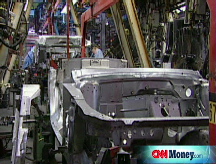Manufacturing index shows surprise strength
Purchasing managers' group says June activity signaled expansion for the first time since January.
NEW YORK (CNNMoney.com) -- A key measure of the nation's manufacturing activity rose unexpectedly in June, reaching a level that indicated expansion in the sector for the first time since January.
But economists saw negative signs in readings about new orders, employment and prices paid.
The Institute for Supply Management's (ISM) manufacturing index rose to 50.2 in June, up from the May reading of 49.6. Economists were expecting a reading of 48.6, according to a consensus estimate compiled by Briefing.com.
The tipping point for the index is 50, with a reading below that reflecting contraction in the sector.
"The manufacturing sector showed a slight improvement in June as the PMI registered above 50% after four months of decline," said Norbert Ore, chair of the ISM's Manufacturing Business Survey Committee.
But the relatively modest change belies some of the more severe moves in the index's components.
"When viewed from the manufacturer's perspective, they are experiencing higher prices for their inputs while demand for their products is slowing," Ore added.
New orders The index showed that new orders for manufactured goods fell in June, the seventh consecutive month, to 49.6 from a reading of 49.7 in May.
"New orders is one of the key components of the index," said Keith Hembre, chief economist at First American Funds. "It gives a sense of underlying demand."
June's reading for new orders puts the index in the bottom third of its range over the last decade, according to Bob Brusca, an economist at FAO Economics.
"That's a pretty weak number," he said.
Price inflation The index's measure of prices that manufacturers pay for materials rose to a reading of 91.5 in June, up 4.5% from May. This is the highest reading for the index since it registered 93.2 in July 1979.
Hembre said the prices paid number is very high and "indicative of a likely profit squeeze."
Higher input costs may also be impacting jobs in the sector.
"Labor is a bigger component of total costs and there may be an effort to squeeze some labor costs to offset non-labor costs," he said.
Employment The index's employment measure fell in June to 43.7 from 45.5 the month before. It was the eighth month in a row that the measure has declined.
"That's disturbing in light of the upcoming jobs report," Brusca said in reference to the Labor Department's monthly report on nonfarm payrolls due Thursday.
"It looks like we're beginning to get some indication that the job market is getting worse," he said.
Exports On the bright side, the index showed that exports in June remained in the range of expansion.
The ISM's measure of exports in June slipped to 58.5 from 59.5 in May. That's still a healthy reading and the export index has been growing for more than 5 years.
Imports, on the other hand, fell 3.5% to a reading of 46 from 49.5 the month before.
"The imports number suggests that domestic demand is still a problem," Brusca said. ![]()




